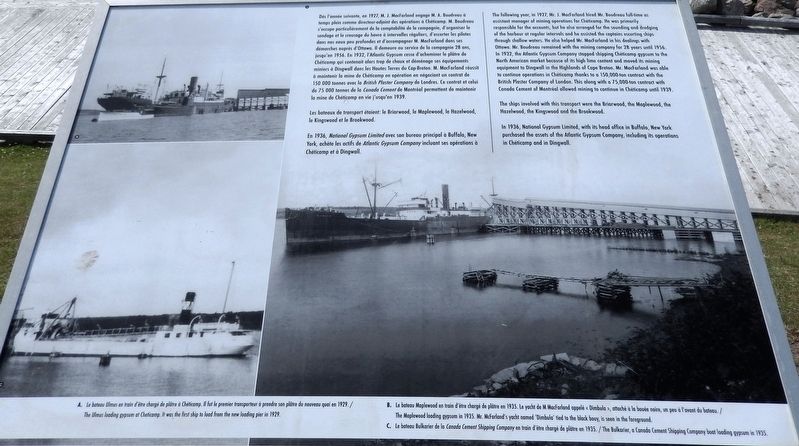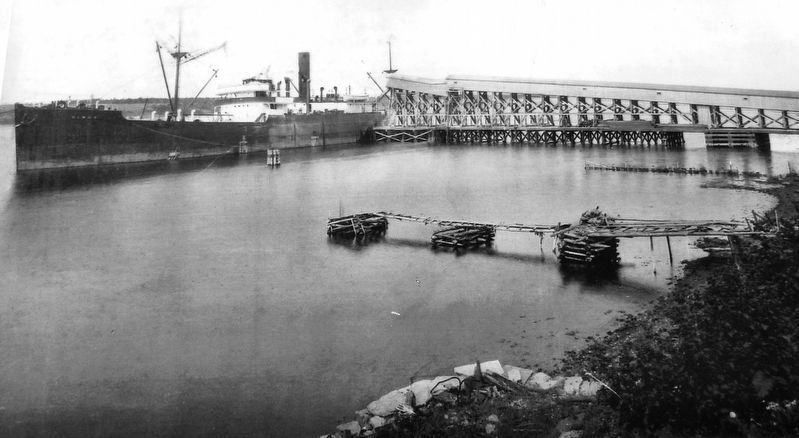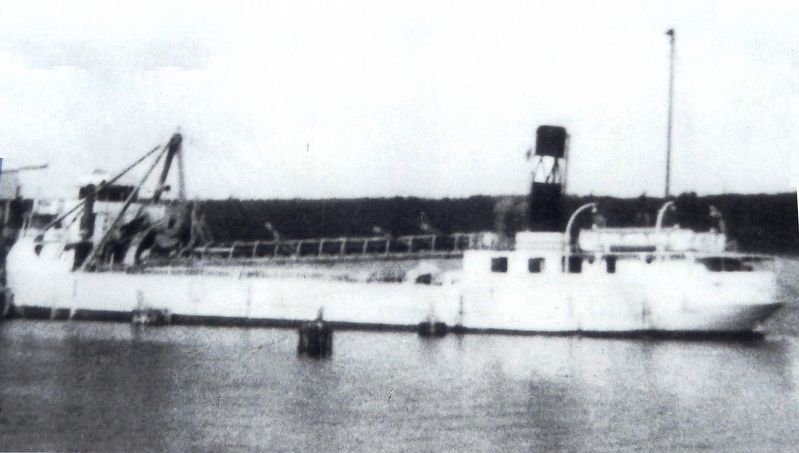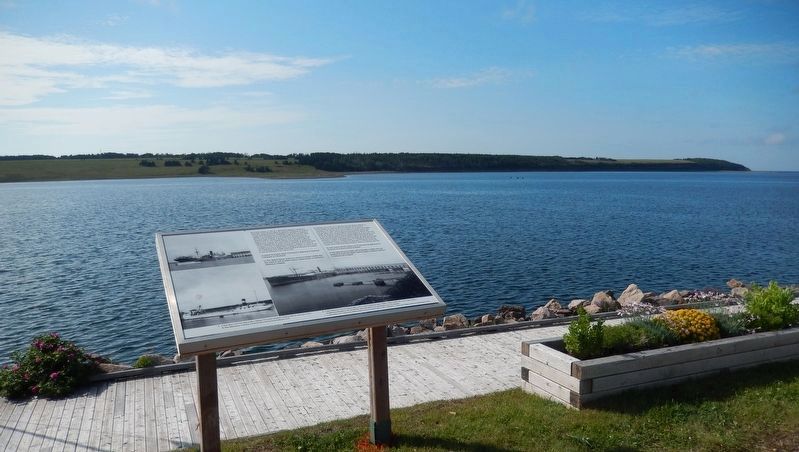Chéticamp in Inverness County, Nova Scotia — The Atlantic Provinces (North America)
Dés l'année suivante, en 1927 / The following year, in 1927
Inscription.
Dés l'année suivante, en 1927, M. J. Macfarland engage M. A. Boudreau à temps plein comme directeur-adjoint des opérations à Chéticamp. M. Boudreau s'occupe particulièrement de la comptabilité de la compagnie, d'organiser le sondage et le creusage du havre à intervalles réguliers, d'escorter les pilotes dans nos eaux peu profondes et d'accompagner M. MacFarland dans ses démarches auprès d'Ottawa. Il demeure au service de la compagnie 28 ans, jusqu'en 1956. En 1932, l'Atlantic Gypsum cesse d'acheminer le plâtre de Chéticamp qui contenait alors trop de chaux et déménage ses équipements miniers à Dingwall dans les Hautes Terres du Cap-Breton. M. MacFarland réussit à maintenir la mine de Chéticamp en opération en négociant un contrat de 150 000 tonnes avec la British Plaster Company de Londres. Ce contrat et celui de 75 000 tonnes de la Canada Cernent de Montréal permettent de maintenir la mine de Chéticamp en vie j'usqu'en 1939.
Les bateaux de transport étaient: le Briarwood, le Maplewood, le Hazelwood, le Kingswood et le Brookwood.
En 1936, National Gypsum Limited avec son bureau principal à Buffalo, New York, achète les actifs de Atlantic Gypsum Company incluant ses opérations Chéticamp et à Dingwall.
The following year, in 1927, Mr. J. MacFarland hired Mr. Boudreau full-time as assistant manager of mining operations for Chéticamp. He was primarily responsible for the accounts, but he also arranged for the sounding and dredging of the harbour at regular intervals and he assisted the captains escorting ships through shallow waters. He also helped Mr. MacFarland in his dealings with Ottawa. Mr. Boudreau remained with the mining company for 28 years until 1956. In 1932, the Atlantic Gypsum Company stopped shipping Chéticamp gypsum to the North American market because of its high lime content and moved its mining equipment to Dingwall in the Highlands of Cape Breton. Mr. Macfarland was able to continue operations in Chéticamp thanks to a 150,000-ton contract with the British Plaster Company of London. This along with a 75,000-ton contract with Canada Cement of Montreal allowed mining to continue in Chéticamp until 1939.
The ships involved with this transport were the Briarwood, the Maplewood, the Hazelwood, the Kingswood and the Brookwood.
In 1936, National Gypsum Limited, with its head office in Buffalo, New York purchased the assets of the Atlantic Gypsum Company, including its operations
in Chéticamp and in Dingwall.
(légendes photo / photo captions: )
A. Le bateau Ulmus en train d'être chargé de plâtre à Chéticamp. Il fut le premier transporteur à prendre son plâtre du nouveau quai en 1929. / The Ulmus loading gypsum at Cheticamp. It was the first ship to load from the new loading pier in 1929.
B. Le bateau Maplewood en train d'être chargé de plâtre en 1935. Le yacht de M MacFarland appelé « Dimbula », attaché à la bouée noire, un peu à l'avant du bateau. / The Maplewood loading gypsum in 1935. Mr. Mcfarland's yacht named “Dimbula” tied to the black bouy, is seen in the foreground.
C. Le bateau Bulkarier de la Canada Cement Shipping Company en train d'être chargé de plâtre en 1935. / The Bulkarier, a Canada Cement Shipping Company boat loading gypsum in 1935.
Topics. This historical marker is listed in these topic lists: Industry & Commerce • Waterways & Vessels. A significant historical year for this entry is 1927.
Location. 46° 37.821′ N, 61° 0.76′ W. Marker is in Chéticamp, Nova Scotia, in Inverness County. Marker can be reached from Cabot Trail just north of Barren Road, on the left when traveling north. Marker is located along the Quai Mathieu Promenade/Boardwalk, overlooking Chéticamp Harbor. Touch for map. Marker is at or near this postal address: 15273 Cabot Trail, Chéticamp NS B0E 1H0, Canada. Touch for directions.
Other nearby markers. At least 8 other markers are within
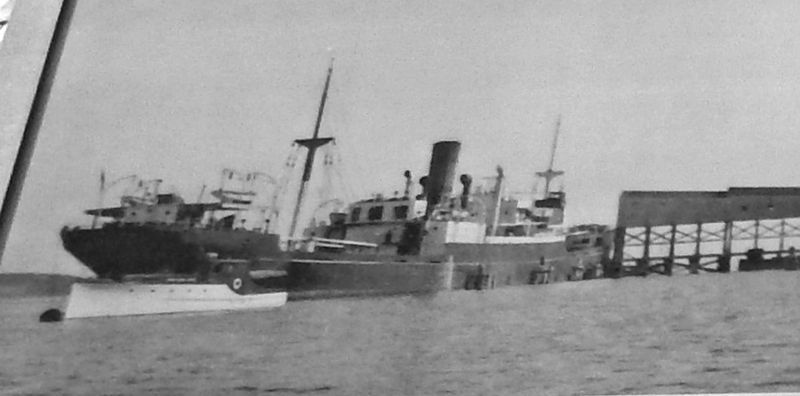
3. Marker detail: The Maplewood loading gypsum in 1935
Mr. Mcfarland's yacht named “Dimbula” tied to the black bouy, is seen in the foreground.
Le bateau Maplewood en train d'être chargé de plâtre en 1935. Le yacht de M MacFarland appelé « Dimbula », attaché à la bouée noire, un peu à l'avant du bateau.
Le bateau Maplewood en train d'être chargé de plâtre en 1935. Le yacht de M MacFarland appelé « Dimbula », attaché à la bouée noire, un peu à l'avant du bateau.
Related markers. Click here for a list of markers that are related to this marker. The Chéticamp Gypsum Mine
Credits. This page was last revised on September 19, 2019. It was originally submitted on September 18, 2019, by Cosmos Mariner of Cape Canaveral, Florida. This page has been viewed 219 times since then and 3 times this year. Photos: 1, 2, 3, 4, 5. submitted on September 19, 2019, by Cosmos Mariner of Cape Canaveral, Florida.
